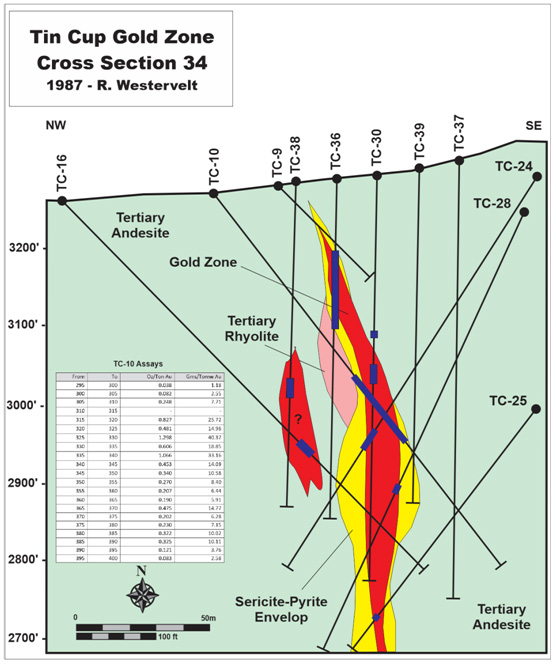Projects
Secret Pass Gold Project
Geology, Previous Production and Exploration Work
The main structural feature in the region is an imbricated system of shallow to steeply dipping faults that trend north-northwest. With reference to Figure 2 this fault system has been traced for approximately 65 km extending from the Oatman District in the south, through the Secret Pass-Frisco Mine area, into the Katherine Gold District. As illustrated on Figure 3, two regional structures, the Union Pass and the Frisco Mine faults, transect the Secret Pass property.

Figure 3: Secret Pass Project Geology and Historic Mine Workings
Numerous gold showings and prospects are associated with the Union Pass and Frisco Mine faults, and some have reported limited gold production. The Oatman District is located approximately 13 km south of Secret Pass property, and has produced over two million ounces of gold.
Mining records indicate that there are 15 historic mine workings located in the Secret Pass license area. The Tin Cup and the FM gold prospects were extensively explored and drilled by Santa Fe Mining and Fischer-Watt from 1984 to 1991. A total of 14,000 metres of drilling was completed in 126 holes including 114 reverse circulation and 12 core holes.
The Tin Cup Gold Zone is localized along the steeply northeast-dipping Frisco Mine Fault. The gold mineralization is hosted by Tertiary andesite and associated with the margins of rhyolite dykes that occur as lenses within the Frisco Mine Fault. A few of the deepest drill holes intersect gold mineralization in the Proterozoic basement granite.
The mineralized zone has a strike length of approximately 245 metres and a drill-indicated depth of up to 180 metres, both open along strike and depth. High-grade mineralization greater than 3 g/t Au, is localized in a 3.0 to 7.6 metres wide, steeply northeast-dipping structure that occurs within a much wider mineralized fault zone that ranges from 30 to 45 metres in width. The mineralization has a northwest plunge and is considered to be open at depth. Surface oxidation extends to a depth of up to approximately 120 metres.
The FM Gold Zone is also controlled by the northwest-trending Frisco Mine Fault that dips steeply to the southwest. Gold mineralization at the FM zone is hosted exclusively by granite and rhyolite and has a strike length of approximately 200 metres and extends to a depth of up to 120 metres, open along strike and depth.
The zone of mineralization ranges from 13 to 30 metres in width at the surface and then transitions into distinct 3.0 to 8.0 meter near-vertical, low-grade (<1.5 g/t Au) structures at depth. Depth of oxidation is variable but is generally extends to a depth of 75 to 100 metres.
Two geological models have been proposed for the Secret Pass gold mineralization. The first model is the epithermal bonanza style veining and hanging wall stockwork setting, with gold mineralization the result of repeated boiling events. This style of mineralization is prevalent in the Oatman Gold District. The second model is a low-angle detachment fault setting, with gold deposition occurring at an oxidation-reduction boundary. This style of mineralization is present in the Katherine Gold District located approximately 15 km to northwest of the Secret Pass Gold Project.
Tin Cup Mine
The Tin Cup mine reportedly produced several hundred tons of mineralized material grading 15 g/t (0.5 oz/t) to 31 g/t (1 oz/t) of gold. Historic workings from the 1930’s included an open pit and an inclined shaft to a depth of 21 metres (70 ft) with minor underground level workings. There has been no known production from the Tin Cup Mine since the 1930’s.
During the period from 1984 to 1991 drilling program, significant gold mineralization was intersected in a number of holes in the Tin Cup Gold Zone. As illustrated in Figure 4, gold assays ranging as high as 40 g/t Au over significant widths at depths ranging from 30 to 180 metres below surface. These results are historical in nature and a qualified person has not done sufficient work to verify these previous drilling intersections.

Figure 4: Historical Cross Section of Tin Cup Gold Zone
(Modified from Arrowstar Resources NI 43 - 101 Report, May 4, 2016. Note this information is historical and has not been verified by a qualified person under the guidelines of NI 43-101)
In summary, the Secret Pass property is transected by two major gold bearing regional structures, the Frisco Mine and Union Pass faults. These faults have combined strike length in excess of 13 km on the property. The last exploration program was completed on the Secret Pass property was in 1991 and was entirely focused on the Tin Cup and FM gold zones which accounts for less than 10% of the total license area. Only the area between Tin Cup and FM gold zones has been drill tested over a strike length of 1.2 km. and very limited surface exploration was conducted on the structures located outside of Tin Cup and FM gold zones.
